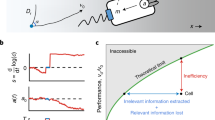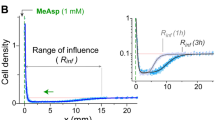Abstract
THE chemotactic behaviour of Escherichia coli provides a useful model for study of the molecular basis of a simple stimulus-response sequence1. Chemical stimuli are detected by specific receptors2 which in turn alter the rotation of the flagella3 to elicit movement towards attractants or away from repellents. About twenty types of chemoreceptors have been identified in E. coli4–6, suggesting that a communication system transmits sensory data from the receptors to the flagella, and that signals from different receptors converge either before or on reaching the flagella. I have attempted to dissect this system by isolating and examining nonchemotactic (che) mutants of the type first described in E. coli by Armstrong et al.7. In this report I summarise the properties of che mutants and derive a model of the chemotaxis machinery based on this genetic analysis.
This is a preview of subscription content, access via your institution
Access options
Subscribe to this journal
Receive 51 print issues and online access
$199.00 per year
only $3.90 per issue
Buy this article
- Purchase on Springer Link
- Instant access to full article PDF
Prices may be subject to local taxes which are calculated during checkout
Similar content being viewed by others
References
Adler, J., Science, 153, 708 (1966).
Adler, J., Science, 166, 1588 (1969).
Larsen, S. H., Reader, R. W., Kort, E. N., Tso, W.-W., and Adler, J., Nature, 249, 74 (1974).
Adler, J., Hazelbauer, G. L., and Dahl, M. M., J. Bact., 115, 824 (1973).
Mesibov, R., and Adler, J., J. Bact., 112, 315 (1972).
Tso, W.-W., and Adler, J., J. Bact., 118, 560 (1974).
Armstrong, J. B., Adler, J., and Dahl, M. M., J. Bact., 93, 390 (1967).
Berg, H. C., and Brown, D. A., Nature, 239, 500 (1972).
Macnab, R. M., and Koshland, jun., D. E., Proc. natn. Acad. Sci., U.S.A., 69, 2509 (1972).
Brown, D. A., and Berg, H. C., Proc. natn. Acad. Sci., U.S.A., 71, 1388 (1974).
Tsang, N., Macnab, R., and Koshland, jun., D. E., Science, 181, 60 (1973).
Berg, H. C., and Anderson, R. A., Nature, 245, 380 (1973).
Silverman, M., and Simon, M., Nature, 249, 73 (1974).
Armstrong, J. B., and Adler, J., Genetics, 61, 61 (1969).
Silverman, M., and Simon, M., J. Bact., 116, 114 (1973).
Hazelbauer, G. L., Mesibov, R. E., and Adler, J., Proc. natn. Acad. Sci. U.S.A., 64, 1300 (1969).
Armstrong, J. B., Thesis, Univ. Wisconsin (1968).
Vary, P. S., and Stocker, B. A. D., Genetics, 73, 229 (1973).
Adler, J., and Tso, W.-W., Science, 184, 1292 (1974).
Author information
Authors and Affiliations
Rights and permissions
About this article
Cite this article
PARKINSON, J. Data processing by the chemotaxis machinery of Escherichia coli. Nature 252, 317–319 (1974). https://doi.org/10.1038/252317a0
Received:
Accepted:
Issue Date:
DOI: https://doi.org/10.1038/252317a0
This article is cited by
-
The effect of amino acids on the motile behavior of Bacillus subtilis
Archives of Microbiology (1977)
-
Bacterial behaviour
Nature (1975)
Comments
By submitting a comment you agree to abide by our Terms and Community Guidelines. If you find something abusive or that does not comply with our terms or guidelines please flag it as inappropriate.



